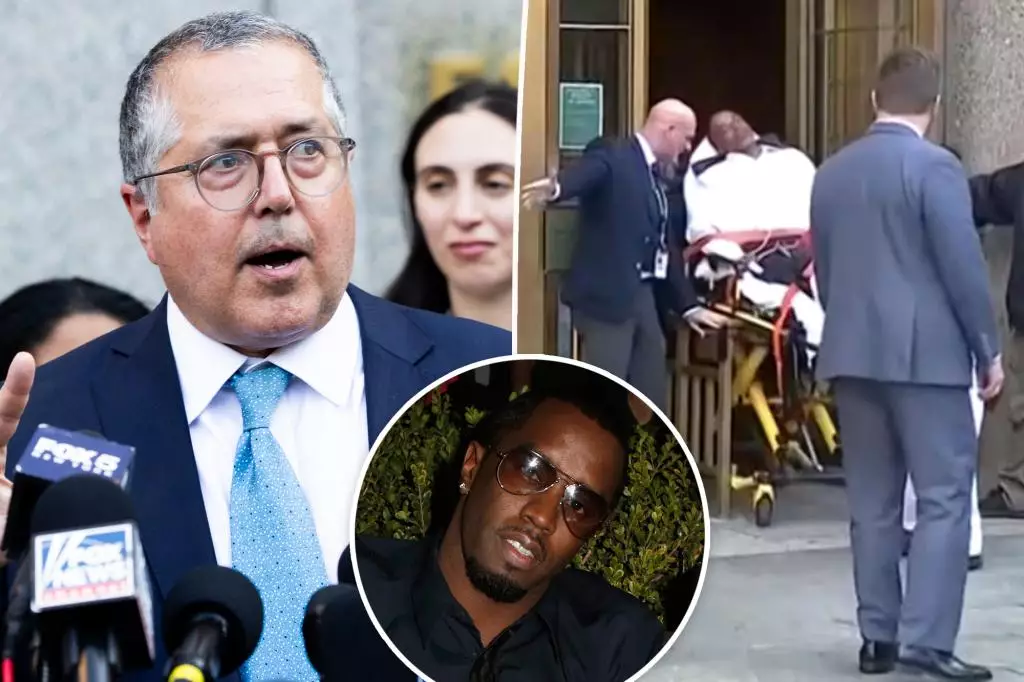Amidst the tension and anticipation of a high-profile legal battle, an ordinary moment of human vulnerability intruded with startling immediacy. While legal teams and journalists focused on Sean “Diddy” Combs’ courtroom proceedings, life outside the protocol suddenly took a grim turn. A civilian collapsed on the 26th floor of the Manhattan federal courthouse, seizing and thrashing in a moment that starkly contrasted the structured veneer of justice with raw human fragility.
This event underscores a profound truth: beneath the veneer of courtrooms and legal battles, the human body remains unpredictable and vulnerable. No amount of wealth, influence, or legal prowess can guarantee immunity from health crises. The scene—blood, vomit, convulsions—reminded everyone present that, regardless of social standing or legal status, health emergencies demand immediate empathy, swift action, and a recognition of our shared fragility.
Rapid Response and Human Compassion in the Midst of Chaos
Lawyers and courthouse staff, often perceived solely through their professional roles, demonstrated instinctive compassion and quick thinking. Marc Agnifilo, a defense attorney with a calm demeanor in the courtroom, found himself in a different setting—saving a life. Without hesitation, he knelt to aid the unresponsive man, employing basic but crucial first aid measures. His partner Jacob Kaplan and others provided vital support, holding the injured man’s head, monitoring breathing, and ensuring his pulse was steady until emergency services arrived.
This incident exemplifies how, in moments of crisis, the human instinct to help transcends roles and titles. It challenges the often cynical view that those in power or influence are detached from human empathy. Rather, it reveals that in emergencies, individuals step beyond their daily personas, driven by the primal instinct to protect life. The courthouse, a symbol of order and rule, became a fleeting arena of chaos met with spontaneous kindness.
The Power Dynamics of Justice Simultaneously Collide with Human Suffering
Meanwhile, the courtroom itself was witness to a different, yet equally compelling, human drama. Sean Combs, a figure synonymous with fame and influence, faced legal verdicts that could significantly alter his life. While his legal team celebrated a notable victory—being acquitted of some charges but convicted on others—the proceedings paled in comparison to the raw human crisis unfolding just beyond the legal judgments.
The stark contrast highlights a critical insight: justice, in its most profound sense, encompasses not just the courtroom’s procedural rigor but also a recognition of inherent human dignity. Combs’ verdicts, variously seen as wins or setbacks, seem almost trivial in the face of a life momentarily saved by spontaneous acts of compassion. The incident brought to light the fleeting boundary between the worlds of power and human vulnerability, reminding us that every individual, regardless of status, can be subject to the unpredictable whims of health and circumstance.
The Role of Public and Professional Responsibility in Moments of Crisis
The response from courthouse personnel raises questions about communal responsibility beyond legal obligations. First responders and legal professionals alike showcased their capacity to prioritize human life over procedural protocol. Their quick coordination and calm presence amid chaos reflect the critical importance of training, preparedness, and empathy in all professional domains.
Furthermore, the incident prompts reflection on how societal structures prepare us—or fail to prepare us—for emergencies. Should legal institutions incorporate more comprehensive emergency response training? Is there a need to embed holistic health awareness into environments where intense emotional and physical stress often converge? The courthouse episode suggests that being ready for human crises is not just a matter of individual competence but also a collective moral obligation.
Beyond the Courtroom: Recognizing Our Collective Humanity
This unforeseen episode at the courthouse serves as a sobering reminder: no matter how glamorous or powerful the figures involved, they—or anyone—are susceptible to life’s unpredictable hardships. The narrative surpasses the legal proceedings to underscore a universal truth—the thin veneer of societal roles and power can be stripped away in an instant by the simple reality of human fragility.
Critical reflection on this event invites us to question how society perceives moments of crisis. Are we genuinely prepared to respond with empathy and swift action? Do our institutions prioritize human well-being alongside the pursuit of justice? The courthouse, a place of judgment and authority, momentarily became a site of shared vulnerability and compassion—an invaluable lesson that reminds us to maintain humility and humanity amid our pursuits of power and success.

